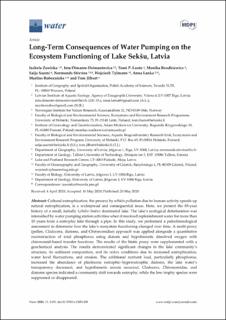Long-Term Consequences of Water Pumping on the Ecosystem Functioning of Lake Sekšu, Latvia
Zawiska, Izabela; Dimante-Deimantovica, Inta; Luoto, Tomi P.; Rzodkiewicz, Monika; Saarni, Saija; Stivrins, Normunds; Wojciech, Tylmann; Lanka, Anna; Robeznieks, Martins; Jilbert, Tom
Peer reviewed, Journal article
Published version

Åpne
Permanent lenke
https://hdl.handle.net/11250/2661598Utgivelsesdato
2020Metadata
Vis full innførselSamlinger
- Publikasjoner fra CRIStin - NINA [2364]
- Scientific publications [1392]
Originalversjon
10.3390/w12051459Sammendrag
Cultural eutrophication, the process by which pollution due to human activity speeds up natural eutrophication, is a widespread and consequential issue. Here, we present the 85-year history of a small, initially Lobelia–Isoëtes dominated lake. The lake’s ecological deterioration was intensified by water pumping station activities when it received replenishment water for more than 10 years from a eutrophic lake through a pipe. In this study, we performed a paleolimnological assessment to determine how the lake’s ecosystem functioning changed over time. A multi-proxy (pollen, Cladocera, diatoms, and Chironomidae) approach was applied alongside a quantitative reconstruction of total phosphorus using diatom and hypolimnetic dissolved oxygen With chironomid-based transfer functions. The results of the biotic proxy were supplemented with a geochemical analysis. The results demonstrated significant changes in the lake community’s structure, its sediment composition, and its redox conditions due to increased eutrophication, water level fluctuations, and erosion. The additional nutrient load, particularly phosphorus, increased the abundance of planktonic eutrophic–hypereutrophic diatoms, the lake water’s transparency decreased, and hypolimnetic anoxia occurred. Cladocera, Chironomidae, and diatoms species indicated a community shift towards eutrophy, while the low trophy species were suppressed or disappeared. eutrophication; water level fluctuation; multi-proxy approach; Cladocera; Chironomidae; diatoms; Northern Europe
